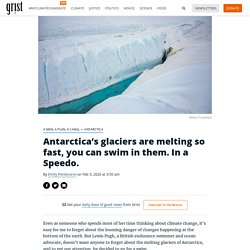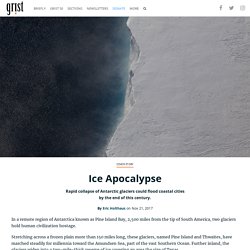

10-12 mai 2021 La fonte du « glacier de l’Apocalypse », en Antarctique, effraie les scientifiques. Réchauffement trois fois plus rapide au Pôle Sud que dans le reste du monde Par AFP - Publié le 29/06/2020 à 17h00 - Mis à jour le 30/06/2020. Coup de chaud sur l'Antarctique : la température y a augmenté à une vitesse folle ces trente dernières années.

Explications. Le Pôle Sud n'est plus à l'abri du réchauffement : la température y a augmenté trois fois plus vite que la moyenne mondiale ces 30 dernières années, en raison de phénomènes naturels "probablement intensifiés" par le changement climatique, selon une étude publiée lundi. L'Antarctique est marqué par une variabilité climatique extrême, avec de fortes différences entre les côtes et l'intérieur du continent, notamment le plateau glacé où se trouve le Pôle Sud.
Ainsi, la majeure partie de l'Antarctique occidental et de la péninsule antarctique ont subi un réchauffement et une fonte des glaces dans la deuxième moitié du XXe siècle. Dans le même temps, au contraire, le Pôle Sud s'est refroidi. Mais le réchauffement de la planète lié aux émissions de gaz à effet de serre produites par les activités humaines n'est pas nécessairement responsable, en tout cas pas tout seul. Antarctica’s ‘green snow’ is sucking carbon out of the air. This story was originally published by Atlas Obscura and is reproduced here as part of the Climate Desk collaboration.

Photosynthesis and Antarctica. It may not be the most intuitive combination, but the icy continent — famous for sculptural icebergs and marching penguins — is also home to communities of blooming algae, mosses, lichens, and even one species of grass. They’re rare, of course: Less than one percent of the entire continent is permanently ice-free to begin with. And what terrestrial vegetation does exist must rely largely on melting snow and ice for its water supply. It’s all part of a fragile ecosystem that scientists are eager to understand as global temperatures rise, affecting not only large sheets of Antarctic ice but also the delicate balance of life there. Antarctica’s glaciers are melting so fast, you can swim in them. In a Speedo. A man, a plan, a canal — Antarctica Even as someone who spends most of her time thinking about climate change, it’s easy for me to forget about the looming danger of changes happening at the bottom of the earth.

But Lewis Pugh, a British endurance swimmer and ocean advocate, doesn’t want anyone to forget about the melting glaciers of Antarctica, and to get our attention, he decided to go for a swim. On January 23, Pugh, who’s 50, became the first person to swim in one of the supraglacial lakes of East Antarctica. Antarctic Ice Sheet Beginning To Crack. Antarcticas-ice-is-melting-6-times-faster-than-in-1979. L'Antarctique fond six fois plus vite qu'il y a 40 ans, avertit une étude.
Lorsqu'elle vibre, la banquise se met à chanter en Antarctique. La fonte des glaces en Antarctique s’accèlère. Two scary Antarctic glaciers might be joining forces to speed up melt. New research from the National Oceanic and Atmospheric Association could help pinpoint snow levels in mountain ranges across the Western United States eight months in advance.

That’s more certainty of the future than we’re getting from most government agencies these days, so we’ll take it! “Snowpack” refers to layers of mountain snow that build up during the winter, harden into large masses of frozen water, and then melt in the spring. That melted snow trickles down to feed rivers and streams, bolster municipal water supplies, and supply farmers with a majority of the water they need to grow crops. Ice Apocalypse. In a remote region of Antarctica known as Pine Island Bay, 2,500 miles from the tip of South America, two glaciers hold human civilization hostage.

Stretching across a frozen plain more than 150 miles long, these glaciers, named Pine Island and Thwaites, have marched steadily for millennia toward the Amundsen Sea, part of the vast Southern Ocean. Further inland, the glaciers widen into a two-mile-thick reserve of ice covering an area the size of Texas. A Massive Iceberg The Size Of Delaware Just Broke Off Antarctica. Here's Why That Matters. This is a guest post from Iissa Ocko, Climate Scientist at Environmental Defense Fund.

This post was co-authored by Mason Fried, a Ph.D. student of glaciology at the University of Texas Institute for Geophysics. Scientists watched with alarm this week as the fourth-largest ice shelf in Antarctica rapidly broke apart, causing an enormous, Delaware-size iceberg to float into the Southern Ocean. Scientists had been observing the anomalous rift widening across a section of the so-called Larsen C ice shelf for the past several years. Now they’re left with some critical questions: What are this event’s broader consequences for the Antarctic ice sheet, what happens next, and – importantly – what role did climate change play here?
For now, it serves as yet another reminder that Antarctica is changing rapidly – and that action to curb rising global temperatures is critical. A trillion-ton iceberg just broke off Antarctica. One of the largest icebergs ever recorded broke off Antarctica’s Larsen C ice shelf earlier this week, according to satellite pictures and scientists who monitor such things, permanently altering the coastline of our planet’s frozen continent.

Twice the size of Long Island and packing a trillion tons of ice — fully melted, that’s enough water to fill Lake Michigan — the newly birthed iceberg seems like a perfect symbol for our overheating world. But there’s a more complex story at play. You might be thinking: Should I have moved to the mountains of Colorado yesterday? Well, this one iceberg itself (likely to be named A68) doesn’t mean much on its own. Its “calving” (as scientists call it) was likely mostly natural, and it was already floating, so it won’t contribute significantly to sea-level rise. But now the clock could be ticking on the collapse of Larsen C itself, kicking off one of the most potentially important natural science experiments in human history. A crucial crack in an Antarctic ice sheet grew 11 miles in only 6 days.
Some highlights:

Antarctica’s collapsing ice shelf just sprouted a new crack. Winter has descended on Antarctica.

Even as cold and darkness blankets the bottom of the world, the region’s most watched ice shelf is is continuing its epic breakdown. A crack started spreading across the Larsen C ice shelf in 2010, reaching 100 miles in length in February. Researchers with Project MIDAS, a British group monitoring the ice shelf, have spotted the first major change to the rift since then. A roughly six-mile crack branching off the main chasm recently formed, further altering the already unstable ice shelf. Antarctica’s fourth biggest ice shelf is on the verge of collapse.
A rift that has been wending its way across Antarctica’s massive Larsen C ice shelf just made another leap forward, growing by more than 10 miles, scientists monitoring it reported Thursday.

Now, a chunk of ice bigger than New York’s Long Island is hanging on by a relative thread. When it breaks off — possibly very soon — it could put the ice shelf in a more precarious position that could eventually lead it to disintegrate. That could contribute further to the global sea-level rise that is threatening the many populous cities that lie within a few miles of the world’s coasts. Des lacs supraglaciaires pourraient accélérer la fonte des glaces en Antarctique. Des scientifiques ont révélé une augmentation du nombre de lacs supraglaciaires en Antarctique de l'Est. En cause : le réchauffement climatique. Antarctica is melting and shows no sign of slowing down. Over the past few years, the evidence has piled up that glaciers in parts of Antarctica have been melting and retreating at an increasingly worrying — and potentially unstoppable — pace.
Now, new research shows that glaciers in a region of West Antarctica that has received relatively little attention to date have lost a considerable amount of ice. And that ice melt and retreat has been going on for decades, longer than previously thought. Say goodbye to major cities if these scientists are right about Antarctica’s collapsing ice. This story was originally published by the Guardian and is reproduced here as part of the Climate Desk collaboration. Sea levels could rise far more rapidly than expected in coming decades, according to new research that reveals Antarctica’s vast ice cap is less stable than previously thought.
The U.N.’s climate science body had predicted up to a meter of sea-level rise this century — but it did not anticipate any significant contribution from Antarctica, where increasing snowfall was expected to keep the ice sheet in balance. Antarctic Ice Shelves Face Major Threat If CO2 Emissions Keep Rising. Climate change is messing with gravity again. The Southern Antarctic Peninsula has dropped the ice equivalent of 350,000 Empire State buildings into the ocean since 2009, according to new research in the journal Science. This level of ice loss is so great that it has actually caused a small shift in gravity, Science Daily reports. Wait – don’t panic! The change in gravity doesn’t mean you’ll have to don a super-cool space suit any time soon. This type of gravity-shifting ice melt was previously documented in Western Antarctica. Here’s how Eric Holthaus explained it at the time: Though we all learned in high school physics that gravity is a constant, it actually varies slightly depending on where you are on the Earth’s surface and the density of the rock (or, in this case, ice) beneath your feet.
So while you’re not at risk of suddenly floating away the next time you walk the dog, you might want to worry over the massive amounts of ice loss. Well, cool. A second giant blob of Antarctic ice is getting ready to drown us. Remember when we found out last year that the West Antarctic ice sheet had started to collapse, that the collapse more or less can’t be stopped, and that it will eventually result in 10 to 15 feet of sea-level rise?
Now we have some more bad news of that caliber. An enormous glacier, one on the other side of the continent from the ailing ice sheet, is doing pretty much the same thing, researchers have discovered. Chris Mooney reports for The Washington Post: The findings about East Antarctica emerge from a new paper just out in Nature Geoscience by an international team of scientists representing the United States, Britain, France, and Australia. They flew a number of research flights over the Totten Glacier of East Antarctica — the fastest-thinning sector of the world’s largest ice sheet — and took a variety of measurements to try to figure out the reasons behind its retreat. Yep, Antarctica is melting away faster than ever. A new report from NASA and UC-Irvine confirms — again — that Antarctica is melting away.
The scientists used observations from four different techniques to measure the amount and change in rate of ice loss from a region in West Antarctica. This area was already known to be melting at an astonishing rate; a recent study using Cryosat 2 showed that in the period from 2010 to 2013, the region was losing ice to the tune of 134 billion metric tons of ice per year. The new study looked at four observation sets covering the years 1992–2013. They found that on average over that time, ice loss from West Antarctica was about 83 billion metric tons per year … but the average increase in that loss was 6.1 billion tons every year. By the end of the time range, the numbers between the new study and the one from CryoSat2 are consistent. This is staggering. En Antarctique, le réchauffement provoque une extension de la banquise. Malgré le réchauffement, la banquise de l'Antarctique s'étend.
Scientists Warn of Rising Oceans as Antarctic Ice Melts. La fonte de glaciers de l'Ouest de l'Antarctique « a atteint un point de non-retour » La fonte des grands glaciers de l'Ouest de l'Antarctique, qui contiennent assez d'eau pour faire monter les océans d'au moins un mètre, s'accélère sous l'effet du réchauffement climatique et paraît irréversible, selon les conclusions de deux études séparées publiées lundi 12 mai. La fonte des six plus grands glaciers de cette région, Pine Island, Thwaites, Haynes, Smith, Pope et Kohler, contribue déjà de façon importante à la montée des océans, lâchant presque autant de glace annuellement dans l'océan que toute la banquise du Groenland. Ils contiennent suffisamment d'eau pour faire grimper le niveau des océans de 1,2 mètre et fondent plus vite que ne le prévoyaient la plupart des scientifiques. Lire : En Antarctique, le glacier du Pin recule inexorablement Regarder la carte interactive sur les impacts du réchauffement climatique Lire : Réchauffement : les 10 points marquants du rapport du GIEC.
Antarctica’s permafrost is melting. Things are getting ugly on Earth’s underside. Antarctic permafrost, which had been weathering global warming far better than areas around the North Pole, is starting to give way. Scientists have recorded some of it melting at rates that are nearly comparable to those in the Arctic.